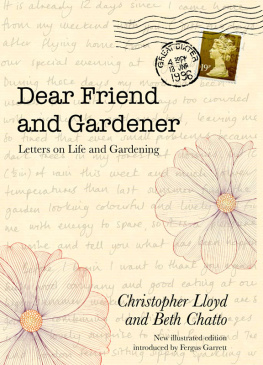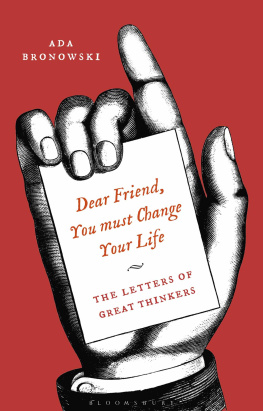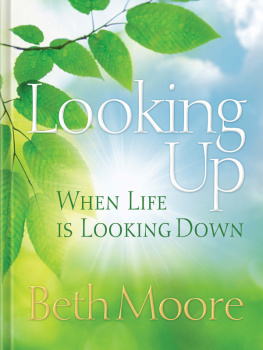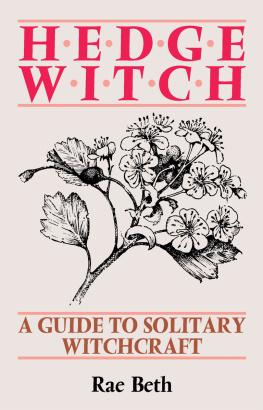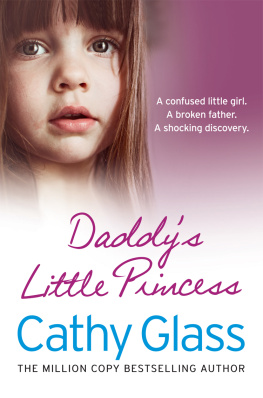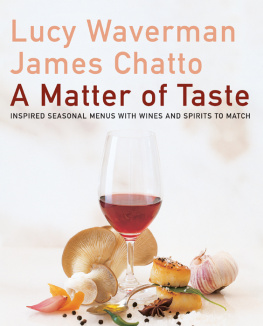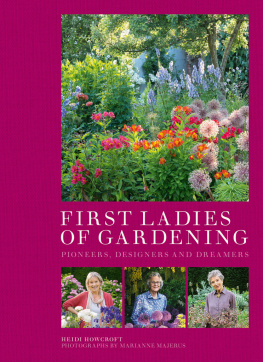Beth Chatto - Dear Friend and Gardener: Letters on Life and Gardening
Here you can read online Beth Chatto - Dear Friend and Gardener: Letters on Life and Gardening full text of the book (entire story) in english for free. Download pdf and epub, get meaning, cover and reviews about this ebook. year: 2013, publisher: Frances Lincoln, genre: Detective and thriller. Description of the work, (preface) as well as reviews are available. Best literature library LitArk.com created for fans of good reading and offers a wide selection of genres:
Romance novel
Science fiction
Adventure
Detective
Science
History
Home and family
Prose
Art
Politics
Computer
Non-fiction
Religion
Business
Children
Humor
Choose a favorite category and find really read worthwhile books. Enjoy immersion in the world of imagination, feel the emotions of the characters or learn something new for yourself, make an fascinating discovery.
- Book:Dear Friend and Gardener: Letters on Life and Gardening
- Author:
- Publisher:Frances Lincoln
- Genre:
- Year:2013
- Rating:4 / 5
- Favourites:Add to favourites
- Your mark:
- 80
- 1
- 2
- 3
- 4
- 5
Dear Friend and Gardener: Letters on Life and Gardening: summary, description and annotation
We offer to read an annotation, description, summary or preface (depends on what the author of the book "Dear Friend and Gardener: Letters on Life and Gardening" wrote himself). If you haven't found the necessary information about the book — write in the comments, we will try to find it.
Lively exchange of letters between Christopher Lloyd and Beth Chatto, two long-established friends and distinguished gardeners.
Beth Chatto: author's other books
Who wrote Dear Friend and Gardener: Letters on Life and Gardening? Find out the surname, the name of the author of the book and a list of all author's works by series.
Dear Friend and Gardener: Letters on Life and Gardening — read online for free the complete book (whole text) full work
Below is the text of the book, divided by pages. System saving the place of the last page read, allows you to conveniently read the book "Dear Friend and Gardener: Letters on Life and Gardening" online for free, without having to search again every time where you left off. Put a bookmark, and you can go to the page where you finished reading at any time.
Font size:
Interval:
Bookmark:
Dear Friend
and Gardener
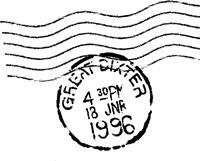
Dear Friend
and Gardener
Letters on Life and Gardening
Christopher Lloyd and Beth Chatto

FOREWORD
From Beth Chatto
Christopher Lloyd and I first met about 20 years ago. It came about through a difference of opinion. On first reading his book The Well-Tempered Garden, I was entertained, amused, informed again and again of things I had forgotten, or things I had never known, tipped head-over-heels by controversial ideas, led on by an opinionated style of writing which far from being off-putting, became addictive but one thing troubled me. He didnt have any time for bergenias, a group of plants I cant garden without! So I wrote him a letter. He replied inviting me to lunch. This was the beginning of our friendship, based on similar values and interests but above all on our passion for plants. Our gardening has been broadened, I think, by our enthusiasm for other forms of art, including music and cooking the whole activated by our need for other people, their responses and input into what we do.
Yet we garden from almost opposite starting points. Christophers garden, historic Great Dixter, is splendid architecturally, both itself and the fine old farm buildings now an integral part of the garden design. Together with ramparts of yew hedging, domes and archways to provide a framework, all are a picture in themselves, timeless, unchanging. Within this framework Christopher experiments with exciting, sometimes revolutionary ideas which both enchant and shock. That is good. Every gardener is an individual, borrowing or rejecting ideas as they fit their character and situation.
I have been gardening for 54 years, influenced in particular by my husband Andrews life-long study of the natural homes of plants. For the first 18 years of our married life we gardened in the home of my late mother-in-law where I learnt to bring up our two daughters, Diana and Mary, discovered which plants would or would not put up with dry chalky boulder clay, and helped my husband run our fruit farm at Elmstead Market, seven miles away. Although I was not aware of it at the time, I was gaining valuable experience, attempting to handle myself and other people and master some of the problems in running a business all needful when it came to starting my own nursery. I had no formal horticultural training, but on the whole I think that has not proved a handicap. Further inspiration and encouragement came from a 36-year-long friendship with the late artist-gardener Sir Cedric Morris, whose plant collection was legendary.
In 1960 my long-hoped-for dream was achieved when we moved into our newly built home on the farm. There was no traditional farmhouse, so we tucked a simple split-level house into the low gravel bank facing an overgrown hollow. Apart from a few ancient oaks there were no remarkable features. The site was wasteland, a wilderness lying between our farm and our neighbours. It consisted of a long spring-fed hollow where the soil lay black and waterlogged, surrounded by sun-baked gravel, situated in one of the driest parts of the country. But it was the extreme variation in growing conditions, from starved gravel to soggy bog, which intrigued us, the possibility lying before us of growing plants adapted to problem areas. Now, 36 years later, we have a series of contrasting yet harmonizing gardens, each based, after trial and error, on plants adapted by nature to different situations.
For me it has been a love affair and lifework to make a garden. During this time our family increased by six grandchildren and now includes my staff and students from around the world. A young Japanese girl, Yuko Tanabe, has been studying here over the past year. Unknown to me, or to Christo, she had been visiting Dixter as part of her training to be a garden designer. She expressed surprise that Christo and I were exchanging letters, and were indeed friends because you are so different. I replied that it was because we each painted our own canvas in our own individual way that our friendship had remained alive and invigorating. At that moment, looking up through the treetops blown bare now of autumn leaves, I noticed the young Paulownia tomentosa, planted about seven years ago, flaunting tip shoots crowded with beige-velvet buds against a pale blue sky. Look Yuko, I said, this is the first year it has made flower buds. She answered, Christopher is the magician, you are the mother. I liked that.
Beth Chatto
Elmstead Market, 1998
From Christopher Lloyd
Unlike my correspondent, I did not have to wrest a garden from a wilderness, nor, for that matter, create a large nursery, with the attendant anxieties of a large staff, whom Beth cares about as though a part of her own family.
Great Dixter, where I was born in 1921, has always been my home. My parents bought the property in 1910. Edwin Lutyens (later Sir Edwin) restored the 15th-century manor house and supervised the additions, which have remained unchanged. He, too, designed the gardens, apart from the Sunk Garden, which was made after the First World War to my fathers design. So the fabric was all instated before I appeared on the scene.
After the Second World War, I took a horticultural degree (B.Sc. Hort.) at Wye College, University of London, and continued there for another four years as an assistant lecturer. I then returned home with the idea of making a living from that base. A love of literature and of letter-writing, instilled by my mother, enabled me to start writing on gardening subjects. My first article (on Lobelia cardinalis) was published in 1952 and my first book, The Mixed Border, in 1957. I also started a small nursery, which I have deliberately kept small so as not to have the anxieties that size brings.
I should explain that I had four brothers and a sister, all of whom moved out of the parental home, though one brother remained on the estate at Little Dixter, and looked after the business side of opening the house and garden to the public, which gradually became of increasing importance. I am now the sole survivor of my generation, none of whom showed the slightest interest in gardening. I did from the start, and my mother was a passionate gardener. During the seven years when I was at Wye College (only 25 miles from Dixter), I would leave her weekly instructions on how to keep the garden going in my absences. She remained mobile to the last week of her 91-year life, dying in 1972. After that I was on my own, but I did not rattle around in a huge barn of a house, as some people supposed. I believed that it should entertain many friends and relations, especially young people, glad to get away from their parental homes but as yet without homes of their own.
With visitor numbers currently up to an annual figure of 35,000; myself writing weekly articles for Country Life magazine (since 1963) and The Guardian, as well as many others, and a book every other year or so; the nursery, thanks to Fergus Garretts energy and organization, becoming much more productive without employing much more staff; that staff being helpful and positive in their attitudes one way and another we are quite a healthy as well as happy enterprise.
Fergus, a friend since his student days, became my head gardener in 1994 and has made possible all sorts of changes in the garden, mainly in terms of planting rather than structure. All this has enabled the financing of major repairs to the house and outbuildings, for it is my main object in life (besides enjoying it!) to pass Dixter on to the next generation in good order.
Next pageFont size:
Interval:
Bookmark:
Similar books «Dear Friend and Gardener: Letters on Life and Gardening»
Look at similar books to Dear Friend and Gardener: Letters on Life and Gardening. We have selected literature similar in name and meaning in the hope of providing readers with more options to find new, interesting, not yet read works.
Discussion, reviews of the book Dear Friend and Gardener: Letters on Life and Gardening and just readers' own opinions. Leave your comments, write what you think about the work, its meaning or the main characters. Specify what exactly you liked and what you didn't like, and why you think so.

